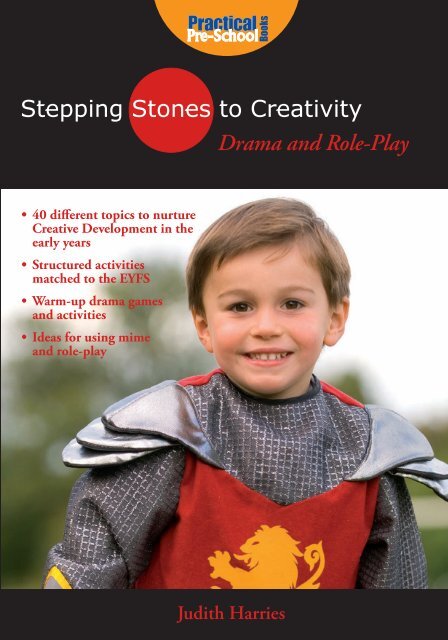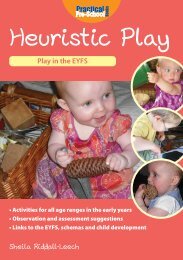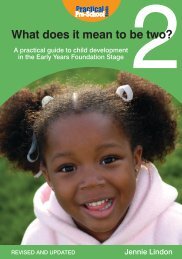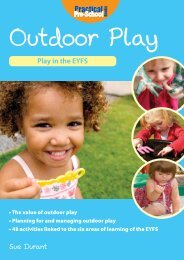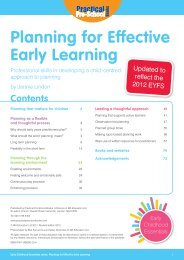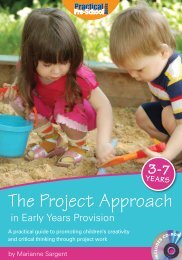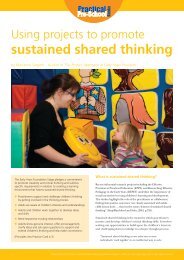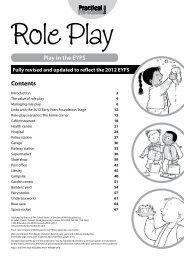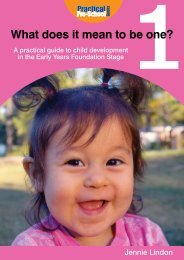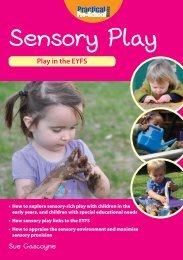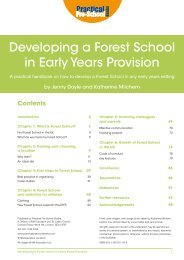Stepping Stones to Creativity - Practical Pre-School Books
Stepping Stones to Creativity - Practical Pre-School Books
Stepping Stones to Creativity - Practical Pre-School Books
Create successful ePaper yourself
Turn your PDF publications into a flip-book with our unique Google optimized e-Paper software.
<strong>Books</strong><br />
<strong>Stepping</strong> <strong>S<strong>to</strong>nes</strong> <strong>to</strong> <strong>Creativity</strong><br />
Drama and Role-Play<br />
• 40 different <strong>to</strong>pics <strong>to</strong> nurture<br />
Creative Development in the<br />
early years<br />
• Structured activities<br />
matched <strong>to</strong> the EYFS<br />
• Warm-up drama games<br />
and activities<br />
• Ideas for using mime<br />
and role-play<br />
Judith Harries
Contents Page<br />
Introduction <strong>to</strong><br />
<strong>Stepping</strong> <strong>S<strong>to</strong>nes</strong> <strong>to</strong> <strong>Creativity</strong> 4<br />
Exploring Drama and Role-Play 5<br />
Topics<br />
Animals, Autumn, Bears 6-7<br />
Clothes, Colours 8-9<br />
Dinosaurs, Families, Farms 10-11<br />
Flight, Food, Friends 12-13<br />
Gardens, Growth, Holes 14-15<br />
Holidays, Houses and Homes, Journeys 16-17<br />
Light, Machines, Materials 18-19<br />
Minibeasts, Night, Numbers 20-21<br />
Opposites, Ourselves, Patterns 22-23<br />
Pets, Pirates, Puppets 24-25<br />
Recycling, Senses, Shapes 26-27<br />
Shopping, Space, Spring 28-29<br />
Summer, Toys, Water 30-31<br />
Weather 32<br />
Winter 33<br />
Guide <strong>to</strong> the Aspects of<br />
Creative Development 35<br />
Published by <strong>Practical</strong> <strong>Pre</strong>-<strong>School</strong> <strong>Books</strong>, A Division of MA Education Ltd,<br />
St Jude’s Church, Dulwich Road, Herne Hill, London, SE24 0PB. Tel: 020 7738 5454 www.practicalpreschoolbooks.com<br />
© MA Education Ltd 2008<br />
Illustrations by Cathy Hughes. Back cover image © Dreamstime.com/Glenda Powers<br />
All rights reserved. No part of this publication may be reproduced, s<strong>to</strong>red in a retrieval system, or transmitted by any means, electronic,<br />
mechanical, pho<strong>to</strong>copied or otherwise, without the prior permission of the publisher.<br />
ISBN 13: 978 1904575 47 4<br />
<strong>Stepping</strong> <strong>S<strong>to</strong>nes</strong> <strong>to</strong> <strong>Creativity</strong> 3
<strong>Stepping</strong> <strong>S<strong>to</strong>nes</strong> <strong>to</strong> <strong>Creativity</strong><br />
<strong>Stepping</strong> <strong>S<strong>to</strong>nes</strong> <strong>to</strong> <strong>Creativity</strong> is a series of books that aim<br />
<strong>to</strong> provide early years practitioners with a treasure trove of<br />
practical activities and resources <strong>to</strong> help develop the budding<br />
creativity of children in their care. Each book focuses on a<br />
different area of creativity, which is explored through forty<br />
of the most popular early years <strong>to</strong>pics. In each <strong>to</strong>pic you will<br />
find activities that support the five Early Learning Goals of<br />
Creative Development, so that you can ensure you are meeting<br />
the requirements of the Early Years Foundation Stage.<br />
Many of these activities can be adapted for even younger<br />
children or extended <strong>to</strong> benefit Key Stage One children.<br />
<strong>Creativity</strong> In The Classroom<br />
<strong>Creativity</strong> is an elusive term. Although great enjoyment can<br />
be taken from working with imaginative children in the Early<br />
Years who are naturally eager <strong>to</strong> explore, in practice there are<br />
some key issues which face the practitioner:<br />
What is ‘creativity’?<br />
In a nutshell, it is the ability <strong>to</strong> use knowledge and skills,<br />
plus a healthy dollop of imagination, <strong>to</strong> tackle and solve any<br />
problem. It is about taking risks and being involved in the<br />
learning process. Creative thinking does not just apply <strong>to</strong><br />
obviously ‘creative’ tasks such as art or music, but can be used<br />
in investigations in science and across the foundation stage<br />
curriculum. To develop creativity children need time, space,<br />
and multiple opportunities <strong>to</strong> experiment with materials and<br />
ideas. They also need <strong>to</strong> be encouraged <strong>to</strong> make connections<br />
between ideas as they play.<br />
How can we as practitioners make this<br />
happen for the children in our care?<br />
Young children are curious by nature. They learn by exploring<br />
and experimenting and ‘having a go’. As practitioners we need<br />
<strong>to</strong> provide a stimulating environment <strong>to</strong>gether with lots of<br />
opportunities and of course unlimited time! Although it can be<br />
a challenge in multi-purpose buildings, a creative environment<br />
can be created by leaving art materials and musical instruments<br />
out for children <strong>to</strong> play and experiment with.<br />
Does there always need <strong>to</strong> be an ‘end<br />
product’ <strong>to</strong> creativity?<br />
Practitioners and parents often both fall in<strong>to</strong> the trap of only<br />
valuing an ‘end product’ as proof of creativity. How many of<br />
us have heard an anxious parent berating their young child<br />
with the words, ‘have you made me a painting this morning<br />
Tom?’ Children sometimes learn <strong>to</strong> rush <strong>to</strong> the painting easel<br />
and apply a few hurried strokes of paint <strong>to</strong> appease their carer,<br />
even though they may have been involved all morning playing<br />
imaginatively and creatively in the role-play area. We need <strong>to</strong><br />
appreciate creative play and processes as just as important as<br />
any finished artwork!<br />
What is the value of creative group work?<br />
In many settings, children often work <strong>to</strong>gether <strong>to</strong> produce joint<br />
artwork and models, as well as singing, drama, dance and music<br />
performances. This can be seemingly problematic, as at times<br />
the individual creative process may have <strong>to</strong> be subordinated <strong>to</strong><br />
the purpose and will of the group. However, group creative work<br />
can provide an ideal opportunity <strong>to</strong> develop children’s social<br />
and co-operative skills. More often than not it requires more<br />
imagination and creativity <strong>to</strong> work as a group!<br />
What can practitioners do <strong>to</strong> develop<br />
children’s creativity?<br />
You may now be feeling how do I encourage children in my<br />
care <strong>to</strong> develop their creativity? The following are useful hints<br />
for nurturing young children’s creativity:<br />
●<br />
●<br />
●<br />
●<br />
●<br />
●<br />
Provide sufficient time and opportunities for children<br />
<strong>to</strong> explore, experiment and practice their skills. Allow<br />
children time <strong>to</strong> work at their own speed. Try <strong>to</strong> avoid<br />
them being pressured by other children eager <strong>to</strong> try<br />
another activity.<br />
Some children require more encouragement <strong>to</strong> ‘have a<br />
go’ on their own. They may need you <strong>to</strong> suggest ideas,<br />
stimulate their imagination, and encourage them. Children<br />
will discover a lot through their own explorations, but<br />
unless there is an adult on hand <strong>to</strong> talk about their<br />
discoveries, learning opportunities can be missed.<br />
Children need <strong>to</strong> feel secure. They need <strong>to</strong> know that<br />
help is available if and when they need it. The tricky<br />
job is judging when <strong>to</strong> intervene if a child is struggling.<br />
Sometimes the process of problem-solving is part of the<br />
learning process, but do be prepared <strong>to</strong> model and teach<br />
new skills that children may require in order <strong>to</strong> progress.<br />
Experience will help you maintain the balance between<br />
being intrusive, and avoiding the frustration children<br />
feel when their own efforts are thwarted.<br />
Supply good quality resources – both materials and<br />
people! Challenge children by inviting artists or<br />
performers <strong>to</strong> show children their own particular area<br />
of creativity. In particular make use of talented parents<br />
who are willing <strong>to</strong> help.<br />
Encourage children <strong>to</strong> talk <strong>to</strong> each other about their<br />
work. Ask them <strong>to</strong> share how they overcame problems<br />
when constructing a model robot, or why they decided<br />
<strong>to</strong> make a loud sound at the end of the music.<br />
Try <strong>to</strong> be creative yourself! How long is it since<br />
you found time <strong>to</strong> develop your own creative gifts?<br />
Challenge yourself <strong>to</strong> learn a new skill this year.<br />
4<br />
<strong>Stepping</strong> <strong>S<strong>to</strong>nes</strong> <strong>to</strong> <strong>Creativity</strong>
Exploring Drama and Role-Play<br />
Creative development is one of the six areas of learning in the<br />
Early Years Foundation Stage – the curriculum for all children<br />
under the age of five. The Statu<strong>to</strong>ry Framework, published<br />
in 2007, breaks down Creative Development in<strong>to</strong> the four<br />
following aspects.<br />
The Four Aspects of Creative<br />
Development:<br />
Being Creative – Responding<br />
<strong>to</strong> Experiences, Expressing and<br />
Communicating Ideas<br />
Corresponding E.L.G.: Respond in a variety of ways<br />
<strong>to</strong> what they see, hear, smell, <strong>to</strong>uch or feel.<br />
Corresponding E.L.G.: Express and communicate<br />
their ideas, thoughts and feelings by using a widening<br />
range of materials, suitable <strong>to</strong>ols, imaginative and<br />
role-play, movement, designing and making, and a<br />
variety of songs and musical instruments.<br />
Exploring Media and Materials<br />
Corresponding E.L.G.: Explore colour, texture,<br />
shape, form and space in two and three dimensions.<br />
Creating Music and Dance<br />
Corresponding E.L.G.: Recognise and explore how<br />
sounds can be changed, sing simple songs from<br />
memory, recognise repeated sounds and sound<br />
patterns and match movements <strong>to</strong> music.<br />
Developing Imagination and<br />
Imaginative Play<br />
Corresponding E.L.G.: Use their imagination in art<br />
and design, music, dance, imaginative and role-play<br />
and s<strong>to</strong>ries.<br />
Interestingly, the actual word ‘drama’ is not included in the Early<br />
Learning Goals for Creative Development but it clearly underlies<br />
a great deal of the goals’ intentions.<br />
A child is surely ‘being creative’ when, through drama and<br />
role-play, they are able <strong>to</strong> show a personal response <strong>to</strong> a dramatic,<br />
if pretend, situation. Drama games and skills enable children <strong>to</strong><br />
‘express and communicate’ their own ideas in a fun,<br />
imaginative and creative way. In an increasingly technological<br />
world children are spoonfed acceptable responses through<br />
exposure <strong>to</strong> passive entertainment in the form of television<br />
programmes and computer games. The world of drama and roleplay<br />
can provide a vital medium for the development of<br />
imagination and imaginative play.<br />
Drama and Role-Play<br />
All practitioners desire <strong>to</strong> extend children’s creativity by<br />
supporting their natural curiosity through play and exploration.<br />
Role-play areas should be inspirational, open-ended environments<br />
that enable children’s creative learning, encouraging them <strong>to</strong><br />
feel safe and secure as they extend their experiences of life. These<br />
environments offer many opportunities <strong>to</strong> develop cross-curricular<br />
learning, in particular language development, awareness of a<br />
variety of cultures, and knowledge and understanding of the<br />
world around us.<br />
Using the activities in this book<br />
Drama games<br />
These games are great as starting points for a drama session, or <strong>to</strong><br />
introduce a new <strong>to</strong>pic <strong>to</strong> your children in a creative way. Many<br />
of them are fun ‘warm-up’ games that help the children <strong>to</strong> relax<br />
and feel comfortable with each other so that they are confident<br />
and able <strong>to</strong> express themselves in a non-threatening environment.<br />
These may be thinking word games, informal circle games, or<br />
energetic physical activities, which require more space and warm<br />
up bodies as well as minds.<br />
Mime<br />
The skills of mime require a great deal of concentration and<br />
these focused activities will develop children’s ability <strong>to</strong> use their<br />
imagination and their bodies <strong>to</strong> tell s<strong>to</strong>ries and describe thoughts<br />
and feelings. Many of the games and activities can be adapted<br />
for use in other <strong>to</strong>pics, for instance the game Mirrors works well<br />
across the <strong>to</strong>pics of ‘Food’, ‘Clothes’ and ‘Ourselves’.<br />
Drama skills<br />
This is the most varied section, which includes the development of<br />
some specific dramatic skills such as ‘freeze frames’, ‘hot-seating’,<br />
retelling s<strong>to</strong>ries, changing the endings of s<strong>to</strong>ries, and character<br />
studies. This section is called ‘Drama skills’ as the activities<br />
involved often extend a skill learned earlier in a drama game or<br />
mime activity. There are lots of suggestions for improvised dramas,<br />
which take the children beyond pretend play in<strong>to</strong> s<strong>to</strong>ries with<br />
characters, dilemmas and crucially, resolutions. These are most<br />
effective if the teacher is prepared <strong>to</strong> go ‘in role’ and join in the<br />
drama <strong>to</strong> sensitively direct where necessary.<br />
Role-play<br />
Each <strong>to</strong>pic is also matched <strong>to</strong> a suitable role-play scenario that can<br />
be set up simply in most settings. Instructions are included for<br />
the equipment required, as well as ideas for making homemade<br />
features. Possible roles that the children might like <strong>to</strong> explore are<br />
listed, along with lots of ideas for s<strong>to</strong>ries <strong>to</strong> be acted out, with or<br />
without teacher input.<br />
<strong>Stepping</strong> <strong>S<strong>to</strong>nes</strong> <strong>to</strong> <strong>Creativity</strong> 5
Dinosaurs<br />
Drama games<br />
●<br />
Action/Freeze: Ask children <strong>to</strong> find a space in the room<br />
and when you shout ‘action’ <strong>to</strong> move freely around<br />
taking care not <strong>to</strong> bump in<strong>to</strong> anybody. When you shout<br />
‘freeze’ they must all stand still like a statue. Then ask<br />
them <strong>to</strong> work in pairs and create contrasting dinosaur<br />
statues – tall and short, big and small, carnivores and<br />
herbivores, spiky and smooth, fast and slow.<br />
Mime<br />
●<br />
Moving dinosaurs: Talk about different sorts of dinosaurs<br />
such as carnivores, herbivores, flying dinosaurs and so<br />
on. Ask children <strong>to</strong> think of different ways <strong>to</strong> move for<br />
each dinosaur.<br />
Drama skills<br />
●<br />
●<br />
The dinosaur egg: Improvise a drama about a group of<br />
children who discover a large plastic egg while on a picnic.<br />
Talk about the characters and plan and prepare the picnic<br />
food. Then travel <strong>to</strong> the picnic in the forest once you find<br />
the egg let the children decide what <strong>to</strong> do with it. Should<br />
they leave it alone, take it home, or break it? Narrate the<br />
ending – make sure the egg is returned <strong>to</strong> where they<br />
found it so that when the mother dinosaur comes back <strong>to</strong><br />
find it out hatches a baby dinosaur!<br />
We’re all going on a dinosaur hunt: Adapt the well-known<br />
rhyme about the bear hunt <strong>to</strong> include dinosaurs!<br />
Role-play<br />
The dinosaur museum<br />
Set up: Create displays of dinosaur bones or pictures. Tickets,<br />
cloakroom, leaflets, a recorded museum guide, museum shop<br />
with <strong>to</strong>ys and postcards. Make model dinosaurs as exhibits<br />
from wire, modroc, papier mache and paint.<br />
Roles: Cura<strong>to</strong>r, <strong>to</strong>ur guides, visi<strong>to</strong>rs, teacher, school party,<br />
dinosaurs.<br />
S<strong>to</strong>ries: Night at the museum – the dinosaur exhibits come <strong>to</strong><br />
life! A school trip <strong>to</strong> the museum in which a child gets lost or<br />
breaks an exhibit. Set up a new display with an exciting new<br />
dinosaur that has just been discovered.<br />
Families<br />
Drama games<br />
●<br />
●<br />
Family voices: Encourage children <strong>to</strong> use different voices<br />
<strong>to</strong> answer the question ‘can you use a daddy voice?’<br />
Change the question <strong>to</strong> mummy, baby, granddad, angry<br />
aunty, unhappy uncle, silly sister, bossy brother etc.<br />
One-line family characters: Sit in a circle and ask children<br />
<strong>to</strong> think of something mum or dad might say. Go round<br />
and invite them <strong>to</strong> deliver a ‘one-line character’ for<br />
others <strong>to</strong> guess. Extend by adding a mood such as angry,<br />
sad, happy or impatient.<br />
Mime<br />
●<br />
Family freeze frames: Explain that you are going <strong>to</strong><br />
arrange the children in<strong>to</strong> family groups and then take<br />
pretend pictures of them. Ask each group <strong>to</strong> talk and<br />
interact with each other and then shout ‘freeze’ as a<br />
signal <strong>to</strong> be still. Try inventing different family situations<br />
such as a celebra<strong>to</strong>ry meal, an outing, an argument etc.<br />
Drama skills<br />
●<br />
Two Fat Gentlemen: Learn the finger rhyme, as shown<br />
below, and then use as a framework for different<br />
family characters such as: two old granddads, two thin<br />
mummies, two tall daddies, two teen sisters, and two<br />
naughty babies. Number the characters 1 – 5 and then<br />
mix and match the numbers <strong>to</strong> create new dramatic<br />
situations where number 1, the old granddad, meets<br />
number 4, the teen sister, and so on.<br />
The Two Fat Gentlemen Finger Rhyme<br />
Two fat gentlemen<br />
Met in a lane<br />
Bowed most politely<br />
And bowed once again<br />
And said ‘How do you do?’<br />
And ‘How do you do?’ again.<br />
10<br />
<strong>Stepping</strong> <strong>S<strong>to</strong>nes</strong> <strong>to</strong> <strong>Creativity</strong>
Role-play<br />
The home corner<br />
Set up: Usual home corner furniture, baby dolls, camera,<br />
presents, baby equipment: food, clothes, wipes, <strong>to</strong>ys, bottles,<br />
high chair, buggy, cot, changing-mat, bath, <strong>to</strong>wels.<br />
Roles: Mum, dad, children, baby, grandparents, aunts, uncles,<br />
neighbours and friends.<br />
S<strong>to</strong>ries: New baby in the family. Act out the baby coming<br />
home: how does everyone in the family feel? The baby cries a<br />
lot and nobody can sleep! Everyone has <strong>to</strong> be quiet so baby can<br />
sleep and every little noise wakes him up! Tidy up the house<br />
ready for visi<strong>to</strong>rs. Organise a celebration or party in the house.<br />
Farms<br />
Drama games<br />
scarecrows could work <strong>to</strong>gether <strong>to</strong> save the farm from<br />
being built on, or gang <strong>to</strong>gether <strong>to</strong> scare away the farmer.<br />
Role-play<br />
The farm and farm shop<br />
Set up: Home corner with lots of cooking utensils, a model<br />
fire made from tissue paper, cellophane, and newspaper. An<br />
outside area with sit-and-ride <strong>to</strong>ys including a trac<strong>to</strong>r, a field<br />
of crops made from corrugated cardboard. A farm shop with<br />
shelves, tables, real or pretend fruit and vegetables, bread,<br />
homemade biscuits, plant pots, <strong>to</strong>ols etc. Make fruit using<br />
screwed up newspaper, modroc and paint. Make real biscuits<br />
<strong>to</strong> sell at the farm shop.<br />
Roles: Farmer, farmer’s wife, children, workers, animals, shop<br />
assistants, cus<strong>to</strong>mers, school children.<br />
S<strong>to</strong>ries: <strong>School</strong> trip <strong>to</strong> visit the farm or shop; a lost animal; the<br />
discovery of a new mystery fruit or vegetable; harvesting crops<br />
on the farm for the harvest festival; making bread. Act out the<br />
traditional s<strong>to</strong>ries The Little Red Hen or The Enormous Turnip.<br />
●<br />
●<br />
Sit in a circle and pass round farm animal sounds trying<br />
not <strong>to</strong> repeat each other. Add suitable actions.<br />
Action/freeze: Ask children <strong>to</strong> find a space <strong>to</strong> stand in.<br />
Make sure they cannot <strong>to</strong>uch anybody near them and<br />
that they have plenty of space <strong>to</strong> move around. When you<br />
shout out ‘action’ invite them <strong>to</strong> move around freely until<br />
you shout ‘freeze’. Then they must freeze and pretend <strong>to</strong><br />
be a farm animal statue or scarecrow of their choice.<br />
Mime<br />
●<br />
●<br />
Down on the farm: Ask children <strong>to</strong> take turns miming<br />
different farm animals for the group <strong>to</strong> guess. Add a<br />
farmer and mime how we use the different animals on<br />
the farm such as milking a cow or riding a horse.<br />
Pass a pretend piece of food around the circle. Start with<br />
an orange that needs <strong>to</strong> be peeled and eaten segment by<br />
segment. Pass it <strong>to</strong> the next child and let them mime a<br />
different piece of food such as a crunchy carrot, banana,<br />
or strawberry. Can the others guess what is being eaten<br />
each time?<br />
Drama skills<br />
●<br />
Scary scarecrows: Talk about scarecrows. Ask the children<br />
<strong>to</strong> pose as a scarecrow; very still but with a scary face!<br />
Improvise a dramatic s<strong>to</strong>ry about scarecrows who<br />
come <strong>to</strong> life. Are they friendly or not? Go in<strong>to</strong> role as<br />
a chief scarecrow and direct the s<strong>to</strong>ry if necessary. The<br />
<strong>Stepping</strong> <strong>S<strong>to</strong>nes</strong> <strong>to</strong> <strong>Creativity</strong> 11


